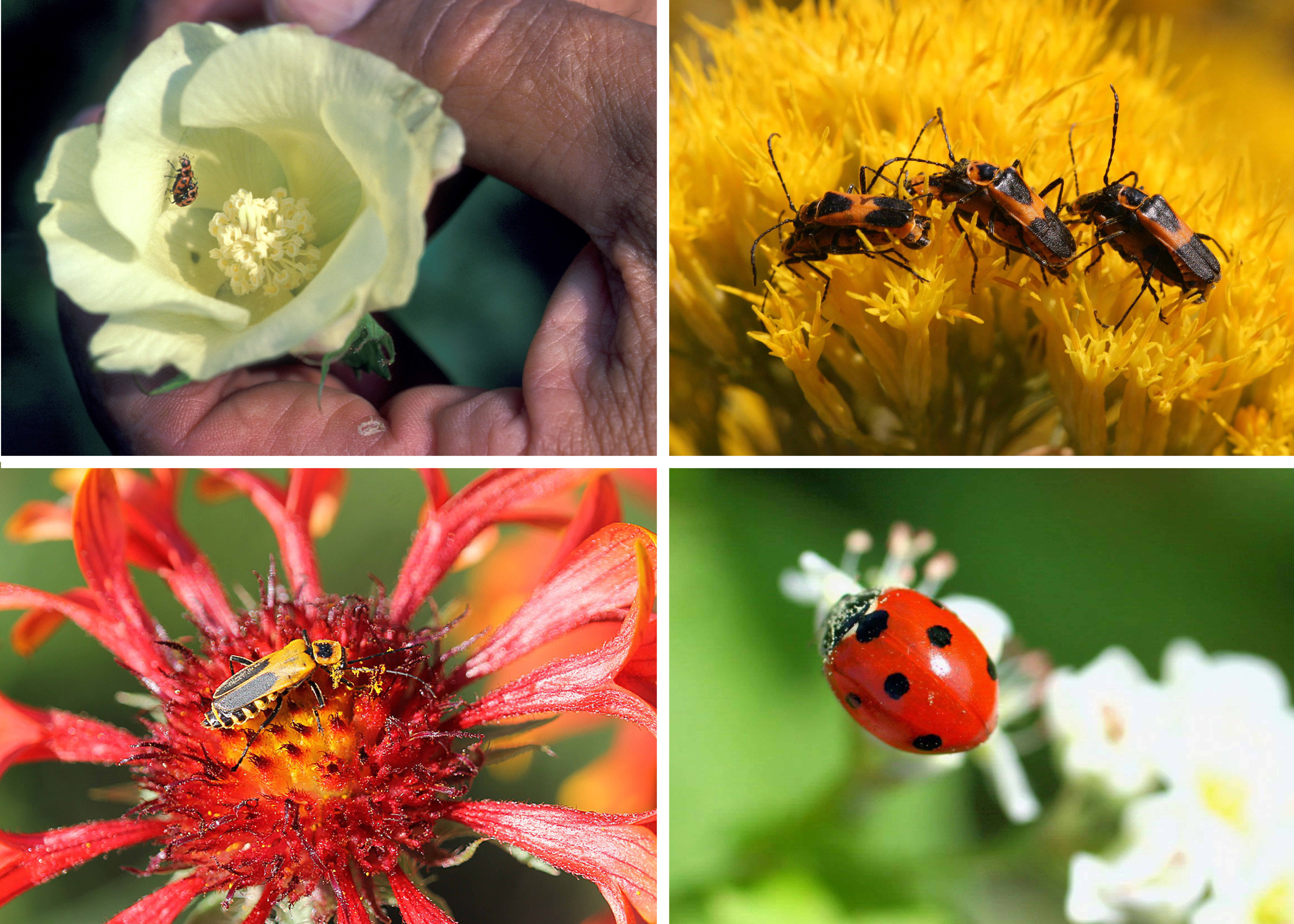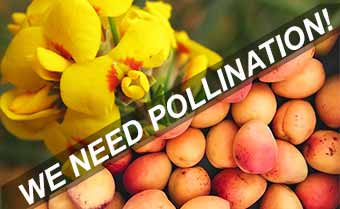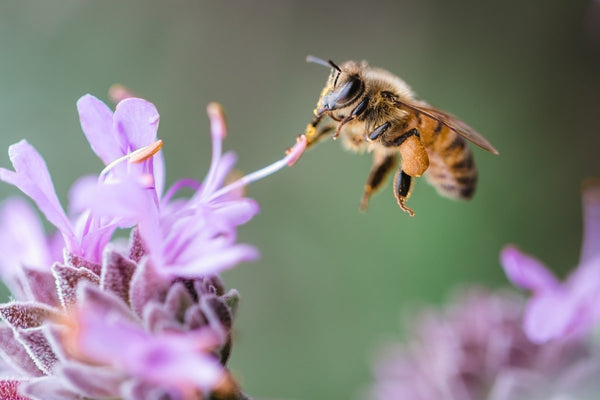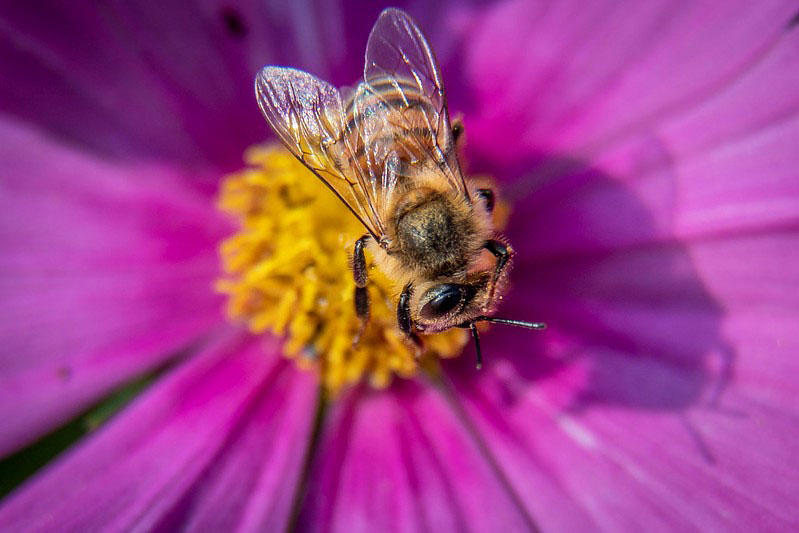1 About pollination » Manaaki Whenua
- Author: landcareresearch.co.nz
- Published Date: 09/13/2022
- Review: 4.89 (882 vote)
- Summary: Honeybees and bumblebees groom themselves and move the collected pollen into ‘pollen baskets’. Female native bees also collect pollen in the same way, but
- Matching search results: Some flowers are arranged so all parts are easily accessible. These “open-access” flowers are visited by a wide range of insects. Because insects can get at the pollen and/or nectar from pretty much any angle, the flower has little control over …
- Source: 🔗
2 Who Are the Pollinators? | Xerces Society

- Author: xerces.org
- Published Date: 10/30/2021
- Review: 4.63 (381 vote)
- Summary: Those with hairs lack the branched, pollen-trapping hairs found on most bees, making them relatively minor pollinators of most plants. Nonetheless, they do
- Matching search results: Beetles are the most diverse group of organisms in the world. In fact, approximately one of every four species of plant, animal, bacterium, or fungus that has been described is a type of beetle. As might be expected in such a large group, beetles …
- Source: 🔗
3 Pollination by bees – Bee Careful
- Author: bee-careful.com
- Published Date: 02/21/2022
- Review: 4.51 (317 vote)
- Summary: Bees smell with their antennae. Thanks to the mobility of the antennae, they can also smell spatially, enabling them to tell which direction the smell is coming
- Matching search results: Beetles are the most diverse group of organisms in the world. In fact, approximately one of every four species of plant, animal, bacterium, or fungus that has been described is a type of beetle. As might be expected in such a large group, beetles …
- Source: 🔗
4 WATCH: Bees buzz unlocks secret stash of pollen
- Author: pbs.org
- Published Date: 05/07/2022
- Review: 4.19 (225 vote)
- Summary: · Plants need a way to get the pollen — basically sperm — to the female parts of another flower. Most plants lure animal pollinators to spread
- Matching search results: Plants need a way to get the pollen — basically sperm — to the female parts of another flower. Most plants lure animal pollinators to spread these male gametes by producing sugary nectar. The bee laps up the sweet reward, is dusted with pollen and …
- Source: 🔗
5 Overview of Bee Pollination and Its Economic Value for Crop Production
- Author: ncbi.nlm.nih.gov
- Published Date: 02/16/2022
- Review: 4.05 (350 vote)
- Summary: · Cultivated plants are typically pollinated by animals. Animal-based pollination contributes to 30% of global food production, and bee-pollinated
- Matching search results: There is an ever-increasing demand for food security in the face of challenges such as climate change, land-use changes, habitat transformation, and the expanding human population. Proper pollination can improve the quantity and quality of fruits, …
- Source: 🔗
6 7 Things You Should Know about Bees and Other Pollinators
- Author: nationalzoo.si.edu
- Published Date: 02/24/2022
- Review: 3.94 (204 vote)
- Summary: · 3. About 70 percent of all flowering plants depend on pollinators. The fruits and seeds that result from insect pollination feed nearly one-
- Matching search results: There is an ever-increasing demand for food security in the face of challenges such as climate change, land-use changes, habitat transformation, and the expanding human population. Proper pollination can improve the quantity and quality of fruits, …
- Source: 🔗
7 Why do we need bees?
- Author: friendsoftheearth.uk
- Published Date: 06/13/2022
- Review: 3.73 (238 vote)
- Summary: · Bees are perfectly adapted to pollinate, helping plants grow, breed and produce food. They do so by transferring pollen between flowering
- Matching search results: Maintaining our native flora also depends on healthy pollinator populations. This includes wild flowers such as poppies, cornflowers and bluebells, as well as trees and shrubs. The close relationship between pollinators and the plants they pollinate …
- Source: 🔗
8 Why are pollinating bats, birds, bees, butterflies, and other animals important?
- Author: usgs.gov
- Published Date: 05/27/2022
- Review: 3.42 (418 vote)
- Summary: Do you enjoy seeing the native flowers and plants that surround you? If so, you depend on pollinators. Wherever flowering plants flourish, pollinating bees,
- Matching search results: Maintaining our native flora also depends on healthy pollinator populations. This includes wild flowers such as poppies, cornflowers and bluebells, as well as trees and shrubs. The close relationship between pollinators and the plants they pollinate …
- Source: 🔗
9 Bees and Pollination – Ypsilanti District Library
- Author: ypsilibrary.org
- Published Date: 10/20/2021
- Review: 3.35 (207 vote)
- Summary: · Bees are essential in growing flowers and plants. They use the process of pollination where they transfer tiny little grains of pollen from the
- Matching search results: Maintaining our native flora also depends on healthy pollinator populations. This includes wild flowers such as poppies, cornflowers and bluebells, as well as trees and shrubs. The close relationship between pollinators and the plants they pollinate …
- Source: 🔗
10 Pollination – Bee Aware
- Author: beeaware.org.au
- Published Date: 09/18/2022
- Review: 3 (263 vote)
- Summary: The process of pollination · Sepals enclose the flower buds. · Petals enclose the reproductive structures. · Anthers produce the pollen and are usually at the end
- Matching search results: Pollination is the movement of pollen from the anthers of a flower to the stigma of the same or a different flower. It is one of the most important parts of the economic production of many crops. However, it is often the most poorly understood and …
- Source: 🔗
11 Information Sheet 10, Honey Bees are Important Pollinators
- Author: cals.arizona.edu
- Published Date: 11/18/2021
- Review: 2.87 (62 vote)
- Summary: Other plants need help from insects, birds, or bats for successful pollination. Without this assistance, fruit and/or seeds would not be formed. In fact, about
- Matching search results: Pollination is the movement of pollen from the anthers of a flower to the stigma of the same or a different flower. It is one of the most important parts of the economic production of many crops. However, it is often the most poorly understood and …
- Source: 🔗
12 Discover why plant pollination is anything but random
- Author: uwm.edu
- Published Date: 12/04/2021
- Review: 2.87 (104 vote)
- Summary: · “When a bee visits the first flower on a plant, 80 percent of the resulting seeds are cross-pollinated,” Karron says. “By the time it alights on
- Matching search results: Pollination is the movement of pollen from the anthers of a flower to the stigma of the same or a different flower. It is one of the most important parts of the economic production of many crops. However, it is often the most poorly understood and …
- Source: 🔗
13 The Why, What, When, Where, Who, How of Pollination
- Author: gardens.si.edu
- Published Date: 05/04/2022
- Review: 2.73 (64 vote)
- Summary: Do you know why some bees buzz? Some plants like tomatoes and blueberries release their pollen through two tiny pores in each anther. Bees bite the anthers,
- Matching search results: Human activities such as farming, housing development, and road construction can fragment a pollinator’s habitat, disconnecting where the pollinator lives from where it forages for food. Pollinator habitats need to be within easy range of food and …
- Source: 🔗
14 Bee pollination: how does it work? – Plantura Garden
- Author: plantura.garden
- Published Date: 06/14/2022
- Review: 2.55 (86 vote)
- Summary: How does bee pollination work? · Bees are attracted to the scent and colour of flowers. · The pollen and nectar found inside a flower are a bee’s main food-source
- Matching search results: Particularly bee-friendly plants, including herbs such as thyme (Thymus vulgaris) and sage (Salvia), bee-friendly flowers such as mallow (Malva) and phacelia (Phacelia) and bee-friendly shrubs such as raspberry (Rubus idaeus) and wild roses (Rosa) …
- Source: 🔗
15 About Pollinators | Pollinator.org
- Author: pollinator.org
- Published Date: 08/05/2022
- Review: 2.53 (196 vote)
- Summary: Birds, bats, butterflies, moths, flies, beetles, wasps, small mammals, and most importantly, bees are pollinators. They visit flowers to drink nectar or feed
- Matching search results: Adding natural habitat areas into farm systems works. Farms that are closer to natural habitat produce more crop yield [9] because they attract more pollinators [10]. Adding habitat to farms systems works too – farms that have turned a potion of …
- Source: 🔗
16 Exploring the Process of Pollination
- Author: perfectbee.com
- Published Date: 12/13/2021
- Review: 2.42 (76 vote)
- Summary: Bees don’t engage in the pollination process merely because they love flowers and plants! They reap huge benefits from participating in the process. As they fly
- Matching search results: Adding natural habitat areas into farm systems works. Farms that are closer to natural habitat produce more crop yield [9] because they attract more pollinators [10]. Adding habitat to farms systems works too – farms that have turned a potion of …
- Source: 🔗
17 The Importance of Bees: Pollination
- Author: bees.techno-science.ca
- Published Date: 11/28/2021
- Review: 2.21 (145 vote)
- Summary: When a bee collects nectar and pollen from the flower of a plant, some pollen from the stamens—the male reproductive organ of the flower—sticks to the hairs of
- Matching search results: Adding natural habitat areas into farm systems works. Farms that are closer to natural habitat produce more crop yield [9] because they attract more pollinators [10]. Adding habitat to farms systems works too – farms that have turned a potion of …
- Source: 🔗
18 WHAT IS POLLINATION AND WHY IS IT IMPORTANT?

- Author: aussiebee.com.au
- Published Date: 09/21/2022
- Review: 2.29 (194 vote)
- Summary: Bees are particularly good pollinators because they need pollen to feed their young in their nests. During the day, bees visit hundreds of flowers to collect
- Matching search results: Other native bees can perform a special kind of pollination called ‘Buzz Pollination’. These bees vibrate the flowers, making the pollen shoot out of little capsules. Some wildflowers, such as Solanum and Hibbertia, require Buzz Pollination to …
- Source: 🔗
19 The Role of The Bee

- Author: edntech.com
- Published Date: 08/01/2022
- Review: 2.01 (76 vote)
- Summary: · Flowers rely on bees to cross-pollinate their female plants. When bees feed on the pollen, their body picks up excess via their pollen-
- Matching search results: As humans, it’s important to understand that the preservation of bees directly correlates to our ecosystems surviving. Bees not only pollinate the flowers that we admire, but they fertilize our crops that we rely on the production of to eat. Because …
- Source: 🔗
20 Bee pollination improves crop quality, shelf life and commercial value
- Author: royalsocietypublishing.org
- Published Date: 03/23/2022
- Review: 1.94 (138 vote)
- Summary: · We expected that: (i) bee-pollinated fruits would have higher … Thus, pollinators were collected across the entire flowering season of the
- Matching search results: As humans, it’s important to understand that the preservation of bees directly correlates to our ecosystems surviving. Bees not only pollinate the flowers that we admire, but they fertilize our crops that we rely on the production of to eat. Because …
- Source: 🔗
21 The Value of Birds and Bees

- Author: farmers.gov
- Published Date: 01/09/2022
- Review: 1.89 (77 vote)
- Summary: · More than 4,000 bee species buzz around the United States. Honey bees alone pollinate 80 percent of all flowering plants, including more
- Matching search results: Pollinators are also a key part of the food web. Insects, like moths, feed more than 80 percent of birds in the U.S., as well as reptiles, amphibians, and mammals. Plus, pollinators contribute to healthy soils and clean water by fostering robust …
- Source: 🔗
